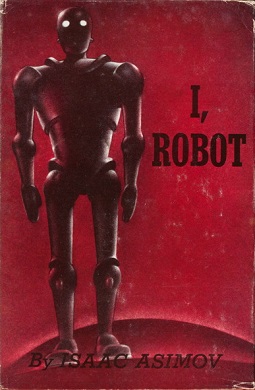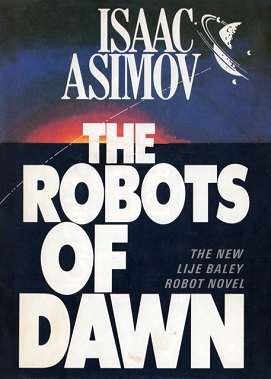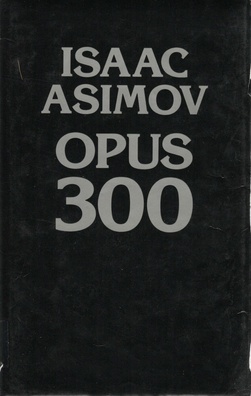
I, Robot is a fixup collection made up of science fiction short stories by American writer Isaac Asimov. The stories originally appeared in the American magazines Super Science Stories and Astounding Science Fiction between 1940 and 1950 and were then compiled into a single publication by Gnome Press in 1950, in an initial edition of 5,000 copies.

Isaac Asimov was an American writer and professor of biochemistry at Boston University. During his lifetime, Asimov was considered one of the "Big Three" science fiction writers, along with Robert A. Heinlein and Arthur C. Clarke. A prolific writer, he wrote or edited more than 500 books. He also wrote an estimated 90,000 letters and postcards. Best known for his hard science fiction, Asimov also wrote mysteries and fantasy, as well as popular science and other non-fiction.

The Robot Series is a series of thirty-seven science fiction short stories and six novels created by American writer Isaac Asimov, from 1940 to 1995. The series is set in a world where sentient positronic robots serve a number of purposes in society. To ensure their loyalty, the Three Laws of Robotics are programmed into these robots, with the intent of preventing them from ever becoming a danger to humanity. Later, Asimov would merge the Robot series with his Foundation series.

The Three Laws of Robotics are a set of rules devised by science fiction author Isaac Asimov, which were to be followed by robots in several of his stories. The rules were introduced in his 1942 short story "Runaround", although similar restrictions had been implied in earlier stories.

Janet Opal Asimov, usually writing as J. O. Jeppson, was an American science fiction writer, psychiatrist, and psychoanalyst.
This is a bibliography of the books written or edited by Isaac Asimov, arranged alphabetically. Asimov was a prolific author, and he engaged in many collaborations with other authors. This list may not yet be complete. The total number of books listed here is over 500. Asimov died in 1992 at age 72; a small number of his books were published posthumously.

Norby, the Mixed-Up Robot is the first book in the Norby series by American authors Janet Asimov and Isaac Asimov. In it, Jefferson Wells and Norby stop Ing from taking over the Solar System with the help of Jeff's brother Fargo Wells, police officer Albany Jones, and Admiral Boris Yobo. According to Isaac Asimov, although Janet Asimov did 90% of the work, his "name was wanted on the book for the betterment of sales [and he] went over the manuscript and polished it a bit." It, along with its sequel, was illustrated for Boys' Life.

Norby is a fictional robot created by Janet Asimov and Isaac Asimov who stars in his own series of children's science fiction books, The Norby Chronicles. His first appearance was in the 1983 book Norby, the Mixed-Up Robot, in total he appeared in 11 novels in the 'Norby' series. According to Isaac Asimov, although Janet Asimov did 90% of the work, his "name was wanted on the book for the betterment of sales [and he] went over the manuscript and polished it a bit."
A robot is a virtual or mechanical artificial agent, usually an electro-mechanical machine.
I, Robot is a 1950 science fiction fixup novel by Isaac Asimov.
Robots named Robert, Robbie/Robby, Rob, and the like, reflect an alliteration trope in science fiction in which robots are given names starting with the letter "r", and particularly with the phoneme "rob". Isaac Asimov noted this in-universe in the short story, "Christmas Without Rodney", in which a character says: "There's no law about it, but you've probably noticed for yourself that almost every robot has a name beginning with R. R for robot, I suppose. The usual name is Robert. There must be a million robot Roberts in the northeast corridor alone". This trope has appeared not only in the English language, but also in languages such as German and Russian. Robots named following this trope include:
Robot Series may refer to:
Humanity most commonly refers to:
In a writing career spanning 53 years (1939–1992), science fiction and popular science author Isaac Asimov (1920–1992) wrote and published 40 novels, 383 short stories, over 280 non-fiction books, and edited about 147 others.
Norby or Nørby is a given name and a surname. Notable people and characters with these names include:
Isaac Asimov wrote three volumes of autobiography. In Memory Yet Green (1979) and In Joy Still Felt (1980) were a two-volume work, covering his life up to 1978. The third volume, I. Asimov: A Memoir (1994), published after his death, was not a sequel but a new work which covered his whole life. This third book won a Hugo Award.
Depending on the counting convention used, and including all titles, charts, and edited collections, there may be currently over 500 books in Isaac Asimov's bibliography—as well as his individual short stories, individual essays, and criticism. For his 100th, 200th, and 300th books, Asimov published Opus 100 (1969), Opus 200 (1979), and Opus 300 (1984), celebrating his writing.

Opus 300 is a collection by American writer and scientist Isaac Asimov. It was published by Houghton Mifflin in the United States in 1984, and by Robert Hale Ltd in the United Kingdom in 1985. Asimov chose to celebrate the publication of his three hundredth book by writing about his previous 99 books, including excerpts from short stories and novels, as well as nonfiction articles and books. Opus 300 also includes nine complete stories, several complete science essays, and one complete essay never before published, "The Forever Generation," which is not available anywhere else.






